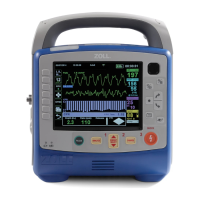Warnings -- SpO2 General
9650-001355-01 Rev. M X Series Operator’s Guide 10-3
Warnings -- SpO
2
General
• As with all medical equipment, carefully route patient cabling to reduce the possibility of
patient entanglement or strangulation.
• Do not place the pulse co-oximeter or accessories in any position that might cause it to fall
on the patient.
• Do not start or operate the pulse co-oximeter unless the setup was verified to be correct.
• Do not use the pulse co-oximeter during magnetic resonance imaging (MRI) or in an MRI
environment.
• Do not use the pulse co-oximeter if it appears or is suspected to be damaged.
• Explosion hazard: Do not use the pulse co-oximeter in the presence of flammable
anesthetics or other flammable substance in combination with air, oxygen-enriched
environments, or nitrous oxide.
• To ensure safety, avoid stacking multiple devices or placing anything on the instrument
during operation.
• To protect against injury, follow the directions below:
• Avoid placing the device on surfaces with visible liquid spills.
• Do not soak or immerse the device in liquids.
• Do not attempt to sterilize the device.
• Use cleaning solutions only as instructed in this operator's manual.
• Do not attempt to clean the device while monitoring patient.
• To protect from electric shock, always remove the sensor and completely disconnect the
pulse co-oximeter before bathing the patient.
• If any measurement seems questionable, first check the patient’s vital signs by alternate
means and then check the pulse co-oximeter for proper functioning.
• Inaccurate respiration rate measurements may be caused by:
• Improper sensor application
• Low arterial perfusion
• Motion artifact
• Low arterial oxygen saturation
• Excessive ambient or environmental noise
• Inaccurate SpCO and SpMet readings can be caused by:
• Improper sensor application
• Intravascular dyes such as indocyanine green or methylene blue
• Abnormal hemoglobin levels
• Low arterial perfusion
• Low arterial oxygen saturation levels including altitude induced hypoxemia
• Elevated total bilirubin levels
• Motion artifact

